Critically Analyzing Social Media's Impact on Walmart's Loyalty
VerifiedAdded on 2020/03/01
|15
|3258
|46
Report
AI Summary
This report critically analyzes the impact of social media marketing on consumer loyalty, using Walmart as a case study. It explores the importance of social media in marketing, techniques used by Walmart, and underlying issues such as inadequate customer contact and content management problems. The report investigates the relationship between social media marketing and brand loyalty, examining the consumer decision journey and current issues in the system. It also reviews relevant theories like the AIDA model and social media sales funnel, offering recommendations for enhancing social media marketing strategies. The study highlights the importance of engaging content, customer interaction, and the use of social exchange theory to build customer loyalty, while also addressing the ethical considerations and literature gaps within the field. The report provides a comprehensive overview of the challenges and opportunities in social media marketing, particularly for large retailers like Walmart.
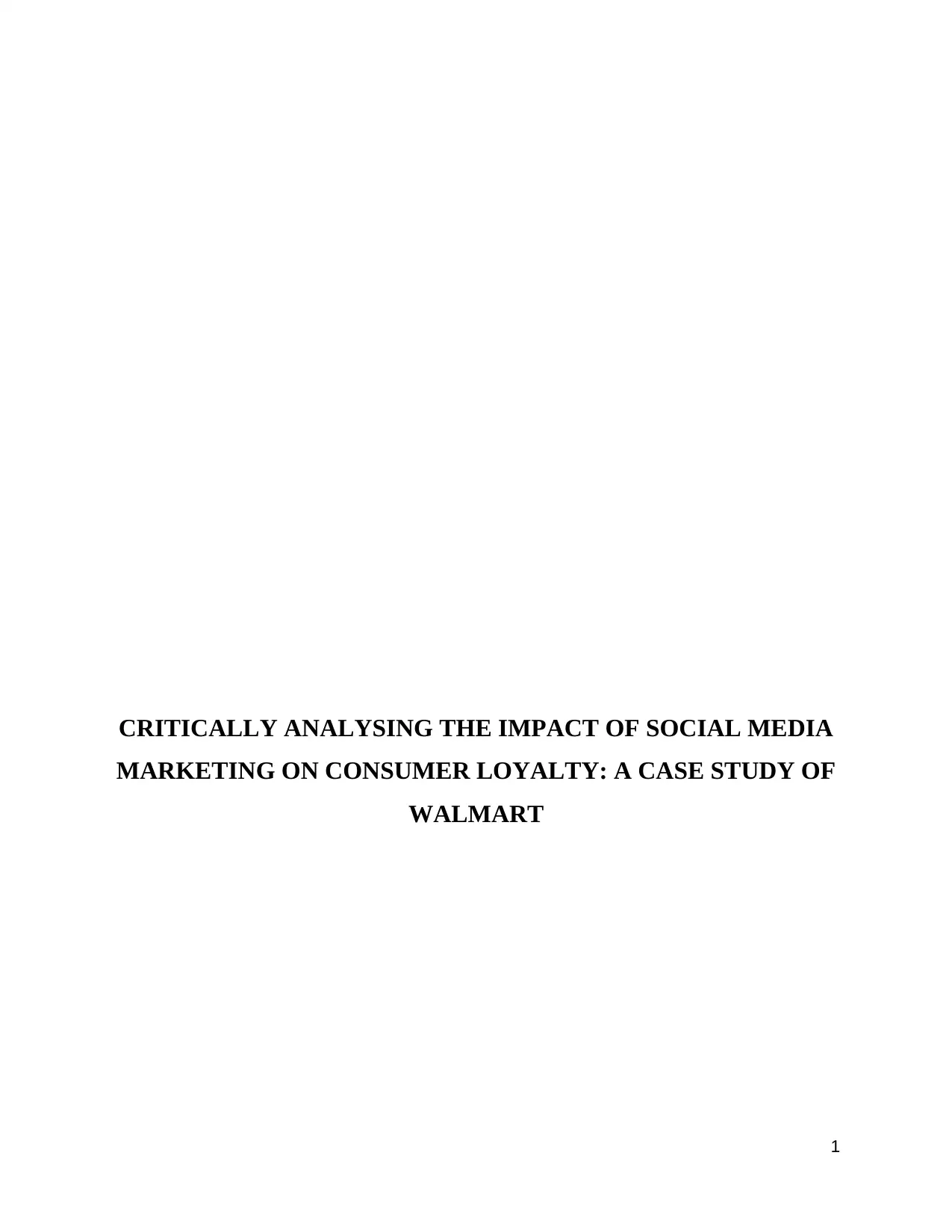
CRITICALLY ANALYSING THE IMPACT OF SOCIAL MEDIA
MARKETING ON CONSUMER LOYALTY: A CASE STUDY OF
WALMART
1
MARKETING ON CONSUMER LOYALTY: A CASE STUDY OF
WALMART
1
Paraphrase This Document
Need a fresh take? Get an instant paraphrase of this document with our AI Paraphraser
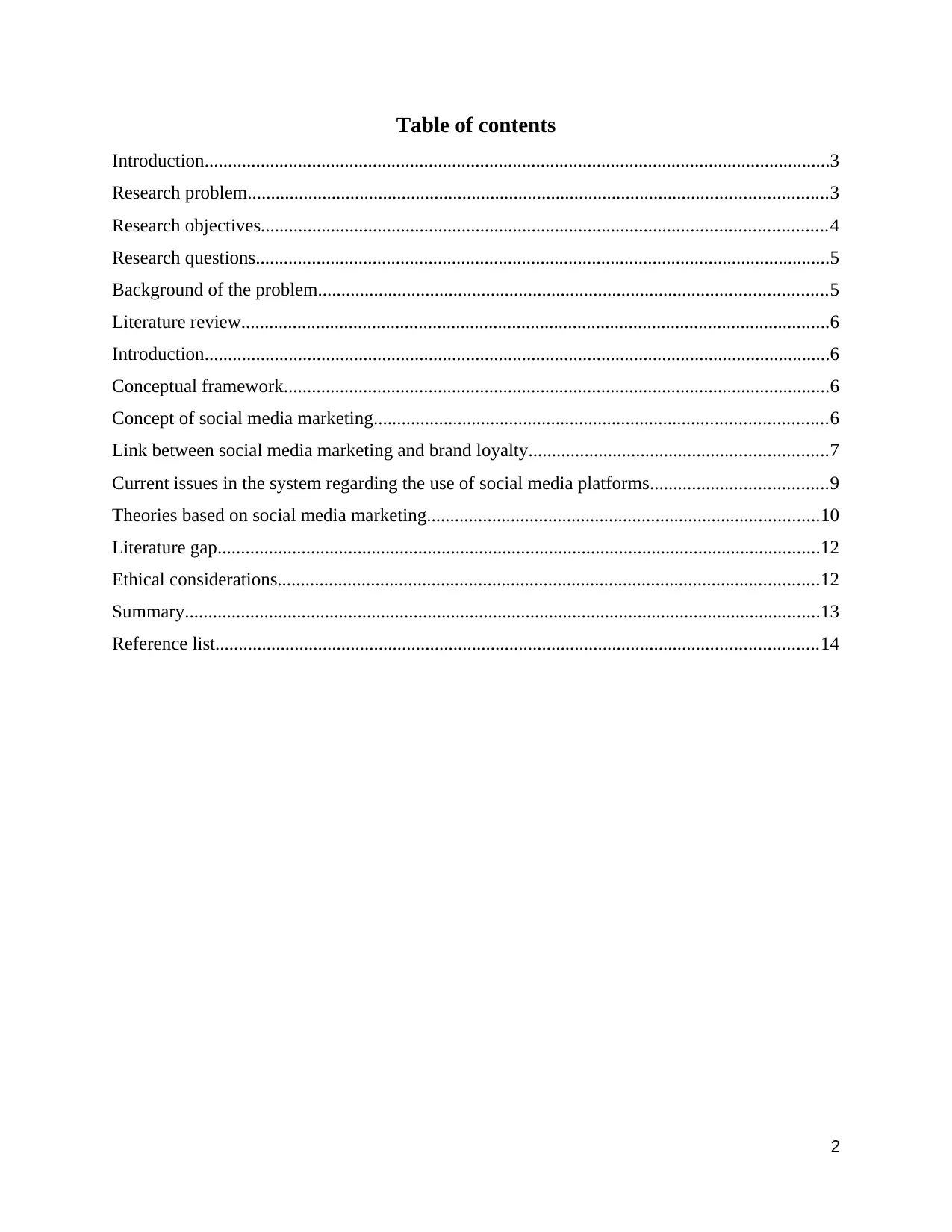
Table of contents
Introduction......................................................................................................................................3
Research problem............................................................................................................................3
Research objectives.........................................................................................................................4
Research questions...........................................................................................................................5
Background of the problem.............................................................................................................5
Literature review..............................................................................................................................6
Introduction......................................................................................................................................6
Conceptual framework.....................................................................................................................6
Concept of social media marketing.................................................................................................6
Link between social media marketing and brand loyalty................................................................7
Current issues in the system regarding the use of social media platforms......................................9
Theories based on social media marketing....................................................................................10
Literature gap.................................................................................................................................12
Ethical considerations....................................................................................................................12
Summary........................................................................................................................................13
Reference list.................................................................................................................................14
2
Introduction......................................................................................................................................3
Research problem............................................................................................................................3
Research objectives.........................................................................................................................4
Research questions...........................................................................................................................5
Background of the problem.............................................................................................................5
Literature review..............................................................................................................................6
Introduction......................................................................................................................................6
Conceptual framework.....................................................................................................................6
Concept of social media marketing.................................................................................................6
Link between social media marketing and brand loyalty................................................................7
Current issues in the system regarding the use of social media platforms......................................9
Theories based on social media marketing....................................................................................10
Literature gap.................................................................................................................................12
Ethical considerations....................................................................................................................12
Summary........................................................................................................................................13
Reference list.................................................................................................................................14
2
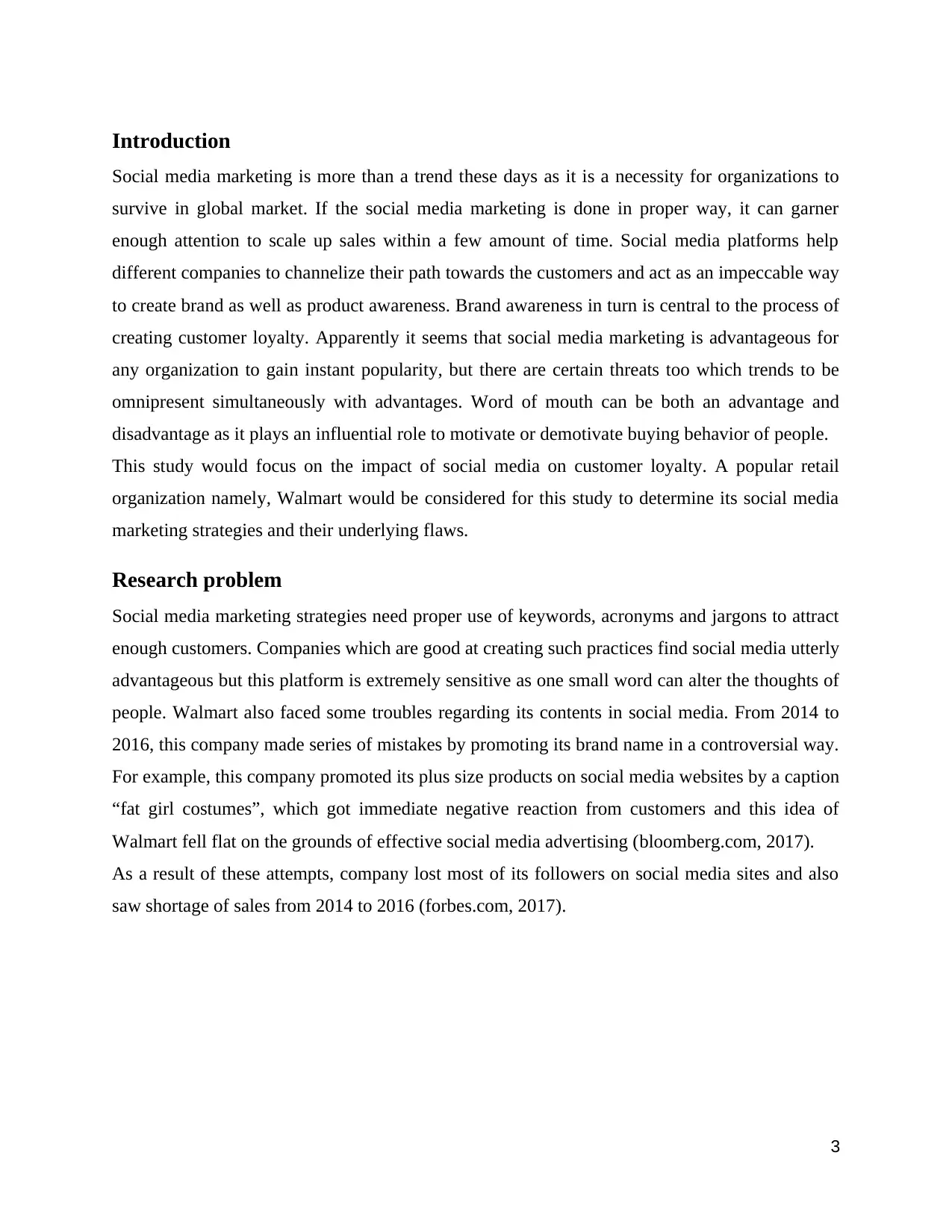
Introduction
Social media marketing is more than a trend these days as it is a necessity for organizations to
survive in global market. If the social media marketing is done in proper way, it can garner
enough attention to scale up sales within a few amount of time. Social media platforms help
different companies to channelize their path towards the customers and act as an impeccable way
to create brand as well as product awareness. Brand awareness in turn is central to the process of
creating customer loyalty. Apparently it seems that social media marketing is advantageous for
any organization to gain instant popularity, but there are certain threats too which trends to be
omnipresent simultaneously with advantages. Word of mouth can be both an advantage and
disadvantage as it plays an influential role to motivate or demotivate buying behavior of people.
This study would focus on the impact of social media on customer loyalty. A popular retail
organization namely, Walmart would be considered for this study to determine its social media
marketing strategies and their underlying flaws.
Research problem
Social media marketing strategies need proper use of keywords, acronyms and jargons to attract
enough customers. Companies which are good at creating such practices find social media utterly
advantageous but this platform is extremely sensitive as one small word can alter the thoughts of
people. Walmart also faced some troubles regarding its contents in social media. From 2014 to
2016, this company made series of mistakes by promoting its brand name in a controversial way.
For example, this company promoted its plus size products on social media websites by a caption
“fat girl costumes”, which got immediate negative reaction from customers and this idea of
Walmart fell flat on the grounds of effective social media advertising (bloomberg.com, 2017).
As a result of these attempts, company lost most of its followers on social media sites and also
saw shortage of sales from 2014 to 2016 (forbes.com, 2017).
3
Social media marketing is more than a trend these days as it is a necessity for organizations to
survive in global market. If the social media marketing is done in proper way, it can garner
enough attention to scale up sales within a few amount of time. Social media platforms help
different companies to channelize their path towards the customers and act as an impeccable way
to create brand as well as product awareness. Brand awareness in turn is central to the process of
creating customer loyalty. Apparently it seems that social media marketing is advantageous for
any organization to gain instant popularity, but there are certain threats too which trends to be
omnipresent simultaneously with advantages. Word of mouth can be both an advantage and
disadvantage as it plays an influential role to motivate or demotivate buying behavior of people.
This study would focus on the impact of social media on customer loyalty. A popular retail
organization namely, Walmart would be considered for this study to determine its social media
marketing strategies and their underlying flaws.
Research problem
Social media marketing strategies need proper use of keywords, acronyms and jargons to attract
enough customers. Companies which are good at creating such practices find social media utterly
advantageous but this platform is extremely sensitive as one small word can alter the thoughts of
people. Walmart also faced some troubles regarding its contents in social media. From 2014 to
2016, this company made series of mistakes by promoting its brand name in a controversial way.
For example, this company promoted its plus size products on social media websites by a caption
“fat girl costumes”, which got immediate negative reaction from customers and this idea of
Walmart fell flat on the grounds of effective social media advertising (bloomberg.com, 2017).
As a result of these attempts, company lost most of its followers on social media sites and also
saw shortage of sales from 2014 to 2016 (forbes.com, 2017).
3
⊘ This is a preview!⊘
Do you want full access?
Subscribe today to unlock all pages.

Trusted by 1+ million students worldwide
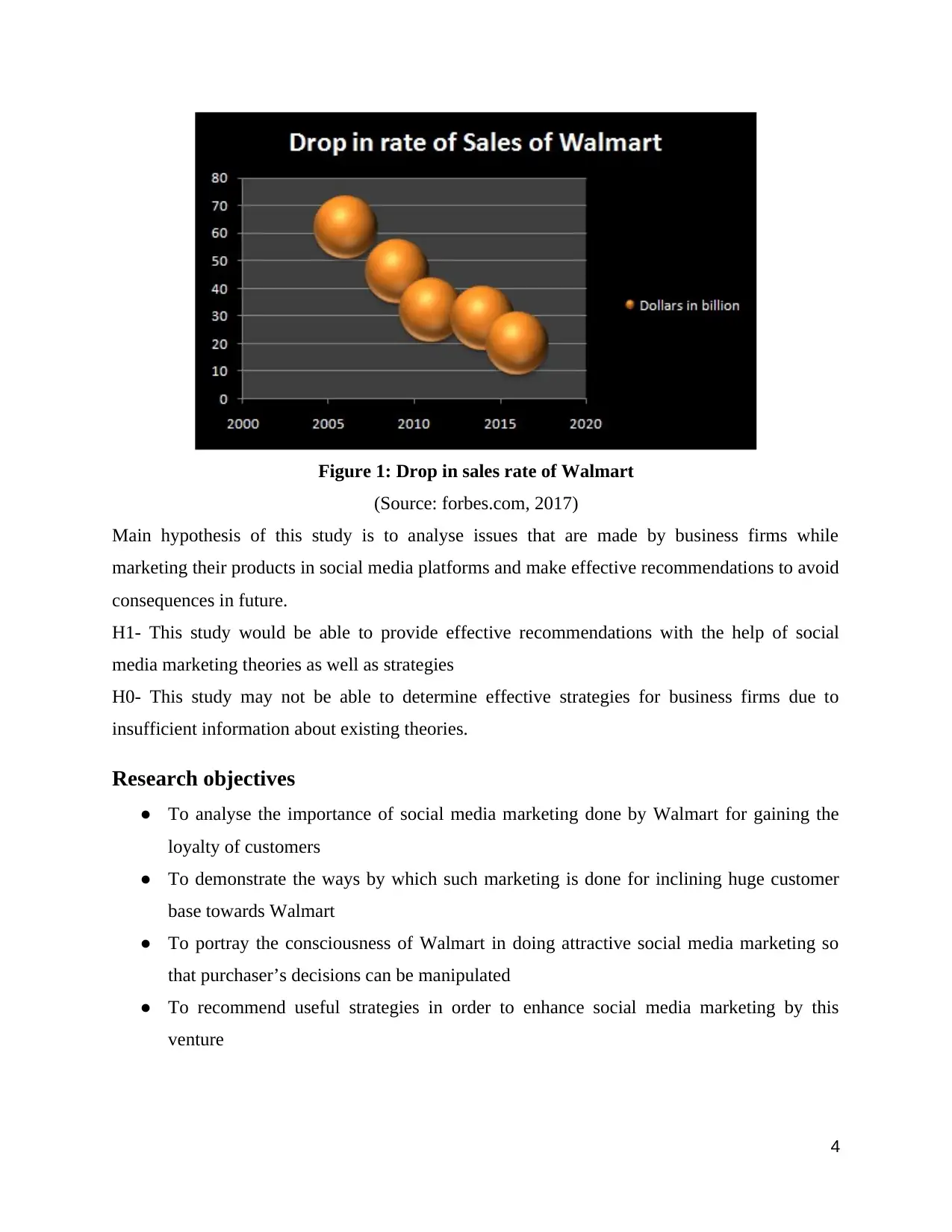
Figure 1: Drop in sales rate of Walmart
(Source: forbes.com, 2017)
Main hypothesis of this study is to analyse issues that are made by business firms while
marketing their products in social media platforms and make effective recommendations to avoid
consequences in future.
H1- This study would be able to provide effective recommendations with the help of social
media marketing theories as well as strategies
H0- This study may not be able to determine effective strategies for business firms due to
insufficient information about existing theories.
Research objectives
● To analyse the importance of social media marketing done by Walmart for gaining the
loyalty of customers
● To demonstrate the ways by which such marketing is done for inclining huge customer
base towards Walmart
● To portray the consciousness of Walmart in doing attractive social media marketing so
that purchaser’s decisions can be manipulated
● To recommend useful strategies in order to enhance social media marketing by this
venture
4
(Source: forbes.com, 2017)
Main hypothesis of this study is to analyse issues that are made by business firms while
marketing their products in social media platforms and make effective recommendations to avoid
consequences in future.
H1- This study would be able to provide effective recommendations with the help of social
media marketing theories as well as strategies
H0- This study may not be able to determine effective strategies for business firms due to
insufficient information about existing theories.
Research objectives
● To analyse the importance of social media marketing done by Walmart for gaining the
loyalty of customers
● To demonstrate the ways by which such marketing is done for inclining huge customer
base towards Walmart
● To portray the consciousness of Walmart in doing attractive social media marketing so
that purchaser’s decisions can be manipulated
● To recommend useful strategies in order to enhance social media marketing by this
venture
4
Paraphrase This Document
Need a fresh take? Get an instant paraphrase of this document with our AI Paraphraser
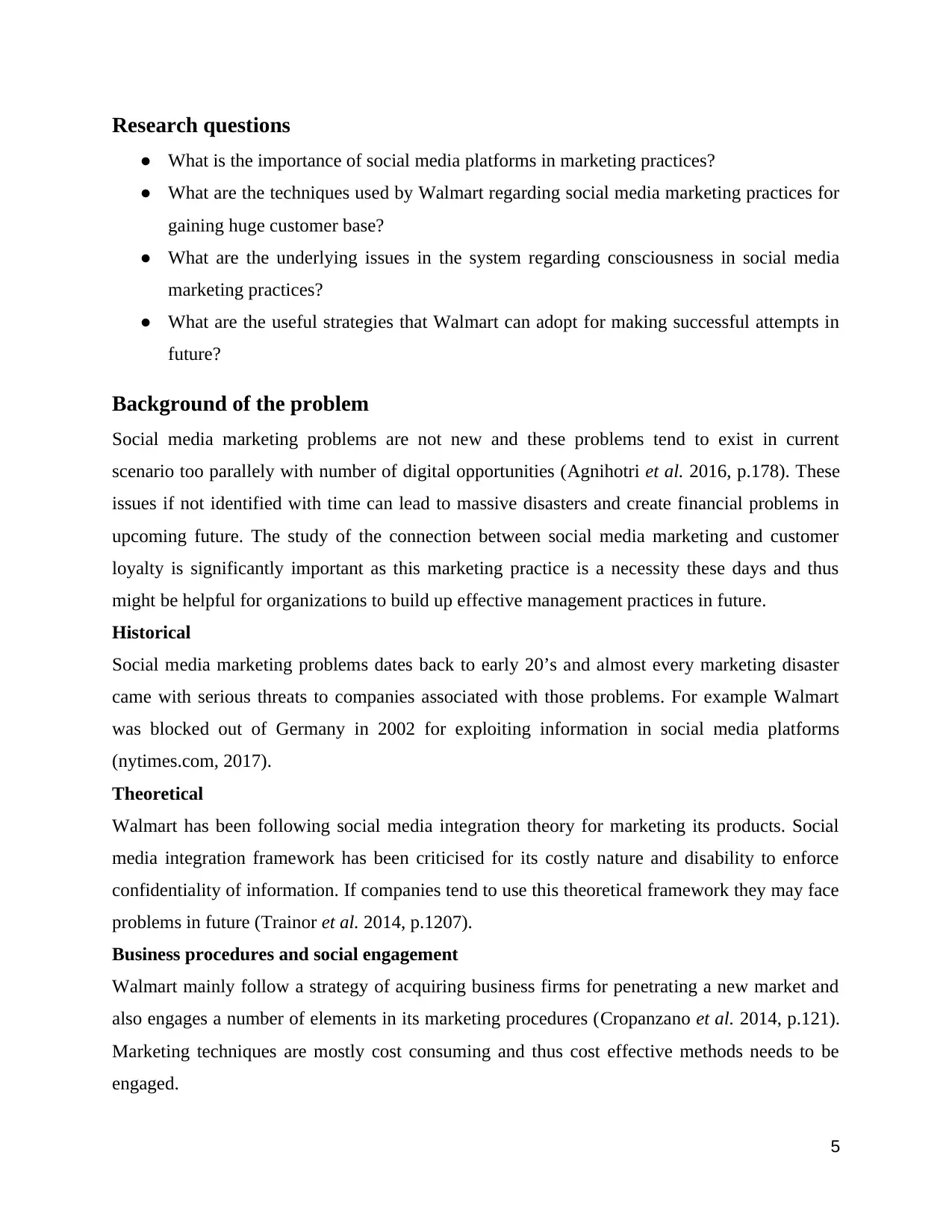
Research questions
● What is the importance of social media platforms in marketing practices?
● What are the techniques used by Walmart regarding social media marketing practices for
gaining huge customer base?
● What are the underlying issues in the system regarding consciousness in social media
marketing practices?
● What are the useful strategies that Walmart can adopt for making successful attempts in
future?
Background of the problem
Social media marketing problems are not new and these problems tend to exist in current
scenario too parallely with number of digital opportunities (Agnihotri et al. 2016, p.178). These
issues if not identified with time can lead to massive disasters and create financial problems in
upcoming future. The study of the connection between social media marketing and customer
loyalty is significantly important as this marketing practice is a necessity these days and thus
might be helpful for organizations to build up effective management practices in future.
Historical
Social media marketing problems dates back to early 20’s and almost every marketing disaster
came with serious threats to companies associated with those problems. For example Walmart
was blocked out of Germany in 2002 for exploiting information in social media platforms
(nytimes.com, 2017).
Theoretical
Walmart has been following social media integration theory for marketing its products. Social
media integration framework has been criticised for its costly nature and disability to enforce
confidentiality of information. If companies tend to use this theoretical framework they may face
problems in future (Trainor et al. 2014, p.1207).
Business procedures and social engagement
Walmart mainly follow a strategy of acquiring business firms for penetrating a new market and
also engages a number of elements in its marketing procedures (Cropanzano et al. 2014, p.121).
Marketing techniques are mostly cost consuming and thus cost effective methods needs to be
engaged.
5
● What is the importance of social media platforms in marketing practices?
● What are the techniques used by Walmart regarding social media marketing practices for
gaining huge customer base?
● What are the underlying issues in the system regarding consciousness in social media
marketing practices?
● What are the useful strategies that Walmart can adopt for making successful attempts in
future?
Background of the problem
Social media marketing problems are not new and these problems tend to exist in current
scenario too parallely with number of digital opportunities (Agnihotri et al. 2016, p.178). These
issues if not identified with time can lead to massive disasters and create financial problems in
upcoming future. The study of the connection between social media marketing and customer
loyalty is significantly important as this marketing practice is a necessity these days and thus
might be helpful for organizations to build up effective management practices in future.
Historical
Social media marketing problems dates back to early 20’s and almost every marketing disaster
came with serious threats to companies associated with those problems. For example Walmart
was blocked out of Germany in 2002 for exploiting information in social media platforms
(nytimes.com, 2017).
Theoretical
Walmart has been following social media integration theory for marketing its products. Social
media integration framework has been criticised for its costly nature and disability to enforce
confidentiality of information. If companies tend to use this theoretical framework they may face
problems in future (Trainor et al. 2014, p.1207).
Business procedures and social engagement
Walmart mainly follow a strategy of acquiring business firms for penetrating a new market and
also engages a number of elements in its marketing procedures (Cropanzano et al. 2014, p.121).
Marketing techniques are mostly cost consuming and thus cost effective methods needs to be
engaged.
5
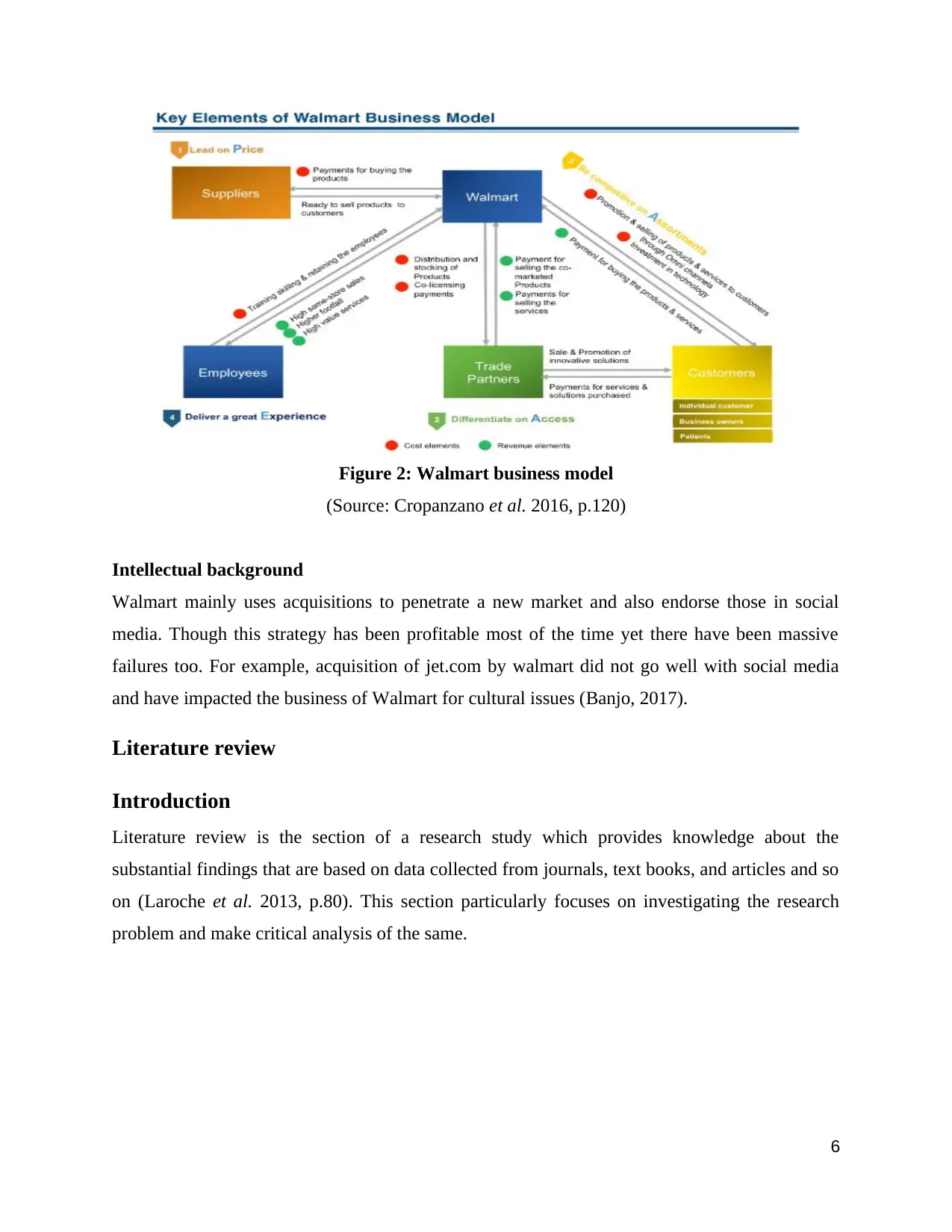
Figure 2: Walmart business model
(Source: Cropanzano et al. 2016, p.120)
Intellectual background
Walmart mainly uses acquisitions to penetrate a new market and also endorse those in social
media. Though this strategy has been profitable most of the time yet there have been massive
failures too. For example, acquisition of jet.com by walmart did not go well with social media
and have impacted the business of Walmart for cultural issues (Banjo, 2017).
Literature review
Introduction
Literature review is the section of a research study which provides knowledge about the
substantial findings that are based on data collected from journals, text books, and articles and so
on (Laroche et al. 2013, p.80). This section particularly focuses on investigating the research
problem and make critical analysis of the same.
6
(Source: Cropanzano et al. 2016, p.120)
Intellectual background
Walmart mainly uses acquisitions to penetrate a new market and also endorse those in social
media. Though this strategy has been profitable most of the time yet there have been massive
failures too. For example, acquisition of jet.com by walmart did not go well with social media
and have impacted the business of Walmart for cultural issues (Banjo, 2017).
Literature review
Introduction
Literature review is the section of a research study which provides knowledge about the
substantial findings that are based on data collected from journals, text books, and articles and so
on (Laroche et al. 2013, p.80). This section particularly focuses on investigating the research
problem and make critical analysis of the same.
6
⊘ This is a preview!⊘
Do you want full access?
Subscribe today to unlock all pages.

Trusted by 1+ million students worldwide
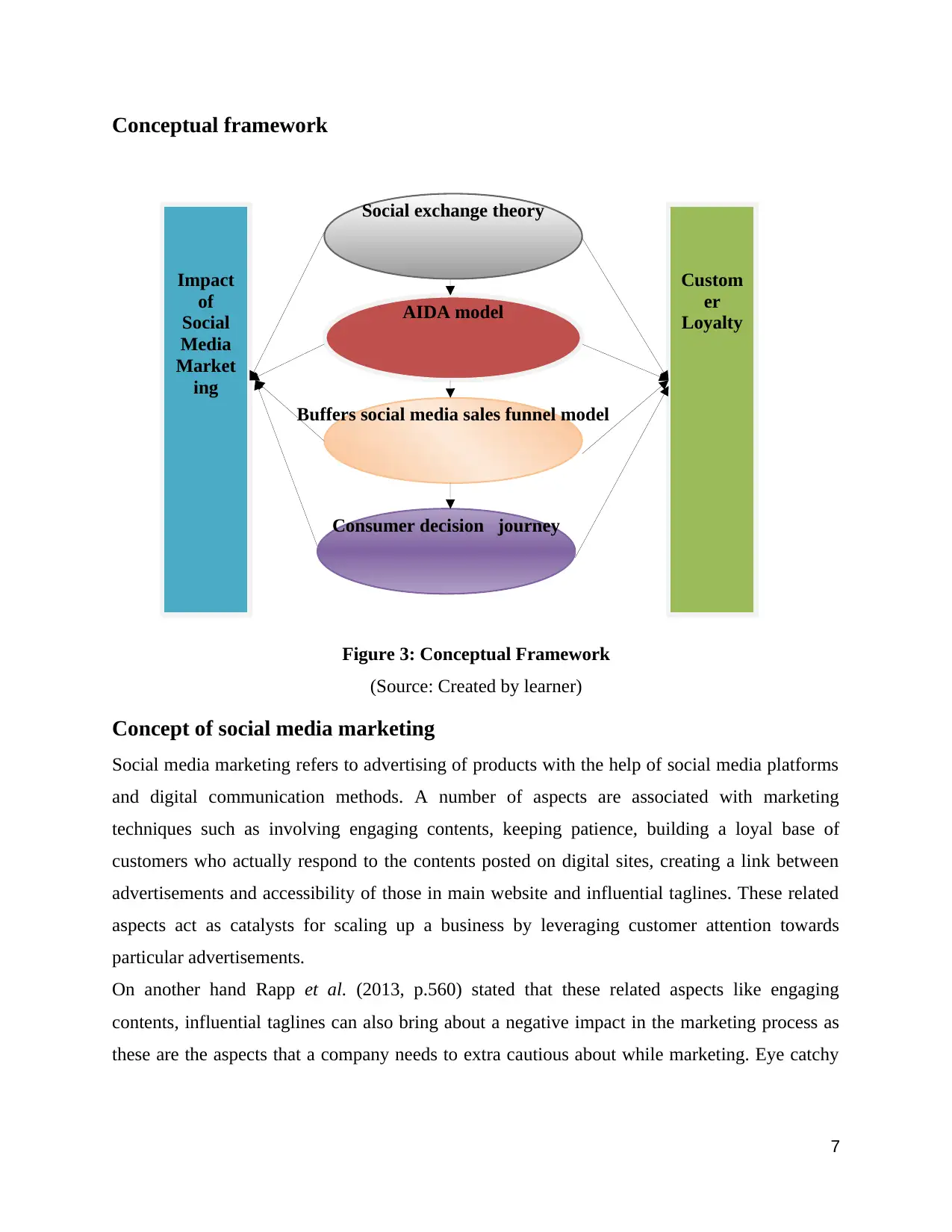
Impact
of
Social
Media
Market
ing
Custom
er
Loyalty
AIDA model
Social exchange theory
Buffers social media sales funnel model
Consumer decision journey
Conceptual framework
Figure 3: Conceptual Framework
(Source: Created by learner)
Concept of social media marketing
Social media marketing refers to advertising of products with the help of social media platforms
and digital communication methods. A number of aspects are associated with marketing
techniques such as involving engaging contents, keeping patience, building a loyal base of
customers who actually respond to the contents posted on digital sites, creating a link between
advertisements and accessibility of those in main website and influential taglines. These related
aspects act as catalysts for scaling up a business by leveraging customer attention towards
particular advertisements.
On another hand Rapp et al. (2013, p.560) stated that these related aspects like engaging
contents, influential taglines can also bring about a negative impact in the marketing process as
these are the aspects that a company needs to extra cautious about while marketing. Eye catchy
7
of
Social
Media
Market
ing
Custom
er
Loyalty
AIDA model
Social exchange theory
Buffers social media sales funnel model
Consumer decision journey
Conceptual framework
Figure 3: Conceptual Framework
(Source: Created by learner)
Concept of social media marketing
Social media marketing refers to advertising of products with the help of social media platforms
and digital communication methods. A number of aspects are associated with marketing
techniques such as involving engaging contents, keeping patience, building a loyal base of
customers who actually respond to the contents posted on digital sites, creating a link between
advertisements and accessibility of those in main website and influential taglines. These related
aspects act as catalysts for scaling up a business by leveraging customer attention towards
particular advertisements.
On another hand Rapp et al. (2013, p.560) stated that these related aspects like engaging
contents, influential taglines can also bring about a negative impact in the marketing process as
these are the aspects that a company needs to extra cautious about while marketing. Eye catchy
7
Paraphrase This Document
Need a fresh take? Get an instant paraphrase of this document with our AI Paraphraser
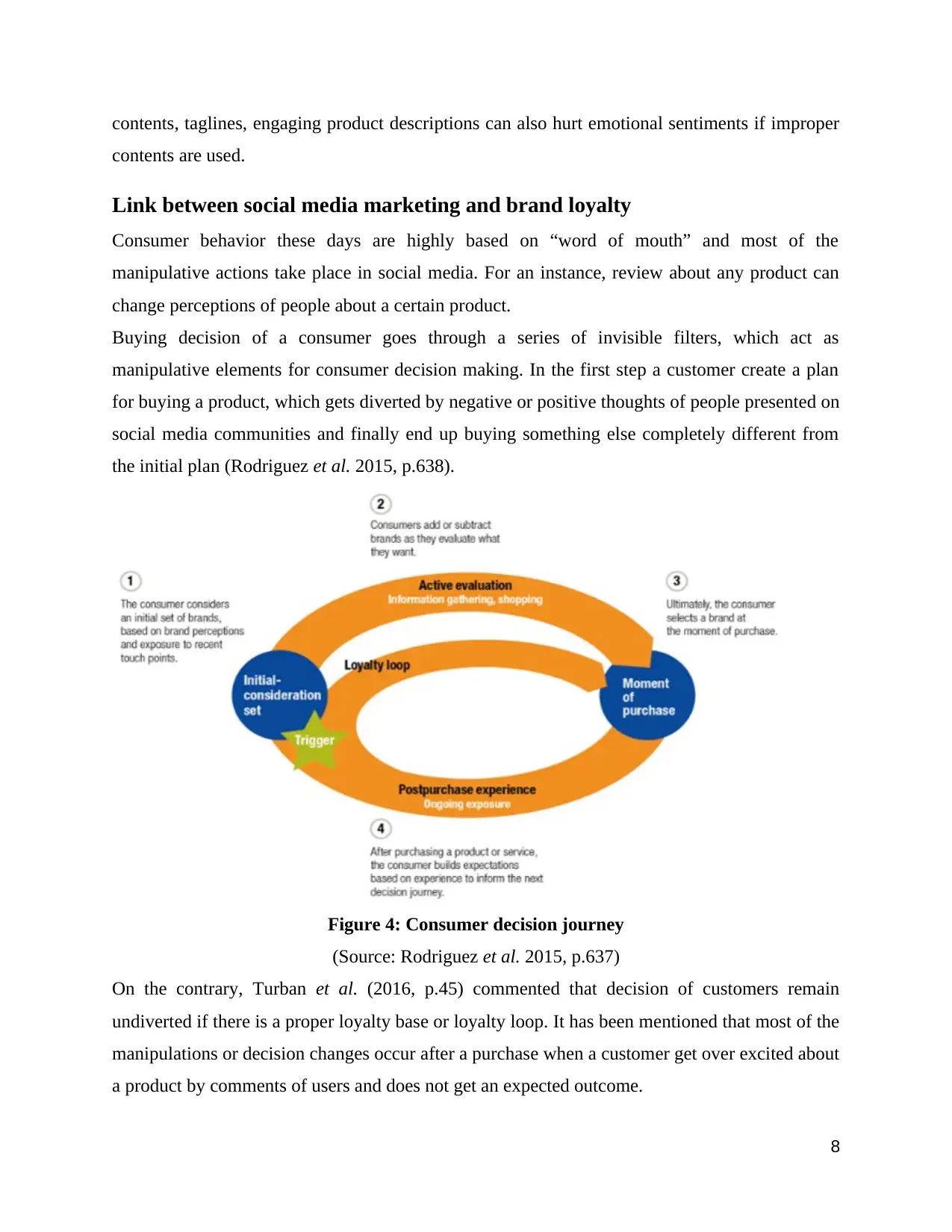
contents, taglines, engaging product descriptions can also hurt emotional sentiments if improper
contents are used.
Link between social media marketing and brand loyalty
Consumer behavior these days are highly based on “word of mouth” and most of the
manipulative actions take place in social media. For an instance, review about any product can
change perceptions of people about a certain product.
Buying decision of a consumer goes through a series of invisible filters, which act as
manipulative elements for consumer decision making. In the first step a customer create a plan
for buying a product, which gets diverted by negative or positive thoughts of people presented on
social media communities and finally end up buying something else completely different from
the initial plan (Rodriguez et al. 2015, p.638).
Figure 4: Consumer decision journey
(Source: Rodriguez et al. 2015, p.637)
On the contrary, Turban et al. (2016, p.45) commented that decision of customers remain
undiverted if there is a proper loyalty base or loyalty loop. It has been mentioned that most of the
manipulations or decision changes occur after a purchase when a customer get over excited about
a product by comments of users and does not get an expected outcome.
8
contents are used.
Link between social media marketing and brand loyalty
Consumer behavior these days are highly based on “word of mouth” and most of the
manipulative actions take place in social media. For an instance, review about any product can
change perceptions of people about a certain product.
Buying decision of a consumer goes through a series of invisible filters, which act as
manipulative elements for consumer decision making. In the first step a customer create a plan
for buying a product, which gets diverted by negative or positive thoughts of people presented on
social media communities and finally end up buying something else completely different from
the initial plan (Rodriguez et al. 2015, p.638).
Figure 4: Consumer decision journey
(Source: Rodriguez et al. 2015, p.637)
On the contrary, Turban et al. (2016, p.45) commented that decision of customers remain
undiverted if there is a proper loyalty base or loyalty loop. It has been mentioned that most of the
manipulations or decision changes occur after a purchase when a customer get over excited about
a product by comments of users and does not get an expected outcome.
8
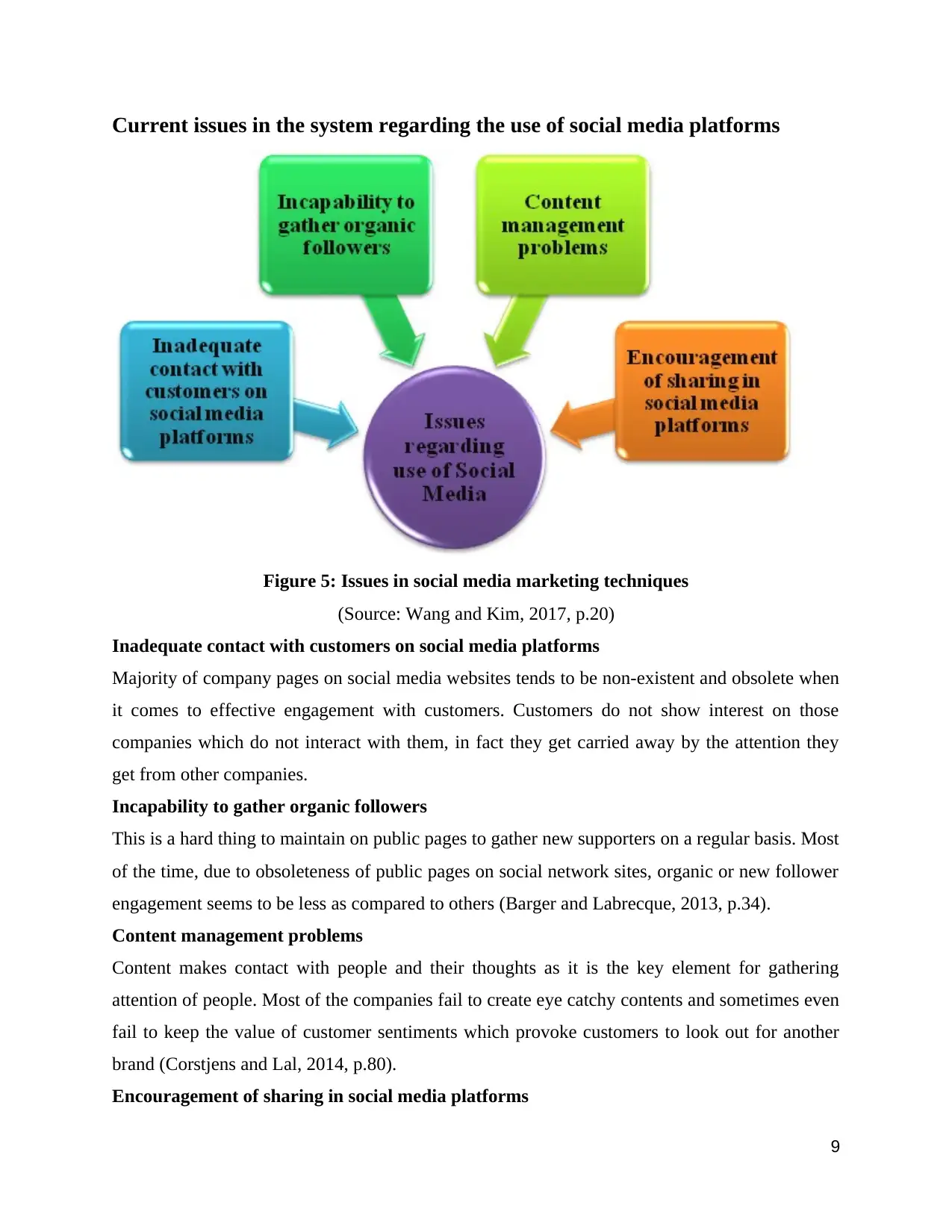
Current issues in the system regarding the use of social media platforms
Figure 5: Issues in social media marketing techniques
(Source: Wang and Kim, 2017, p.20)
Inadequate contact with customers on social media platforms
Majority of company pages on social media websites tends to be non-existent and obsolete when
it comes to effective engagement with customers. Customers do not show interest on those
companies which do not interact with them, in fact they get carried away by the attention they
get from other companies.
Incapability to gather organic followers
This is a hard thing to maintain on public pages to gather new supporters on a regular basis. Most
of the time, due to obsoleteness of public pages on social network sites, organic or new follower
engagement seems to be less as compared to others (Barger and Labrecque, 2013, p.34).
Content management problems
Content makes contact with people and their thoughts as it is the key element for gathering
attention of people. Most of the companies fail to create eye catchy contents and sometimes even
fail to keep the value of customer sentiments which provoke customers to look out for another
brand (Corstjens and Lal, 2014, p.80).
Encouragement of sharing in social media platforms
9
Figure 5: Issues in social media marketing techniques
(Source: Wang and Kim, 2017, p.20)
Inadequate contact with customers on social media platforms
Majority of company pages on social media websites tends to be non-existent and obsolete when
it comes to effective engagement with customers. Customers do not show interest on those
companies which do not interact with them, in fact they get carried away by the attention they
get from other companies.
Incapability to gather organic followers
This is a hard thing to maintain on public pages to gather new supporters on a regular basis. Most
of the time, due to obsoleteness of public pages on social network sites, organic or new follower
engagement seems to be less as compared to others (Barger and Labrecque, 2013, p.34).
Content management problems
Content makes contact with people and their thoughts as it is the key element for gathering
attention of people. Most of the companies fail to create eye catchy contents and sometimes even
fail to keep the value of customer sentiments which provoke customers to look out for another
brand (Corstjens and Lal, 2014, p.80).
Encouragement of sharing in social media platforms
9
⊘ This is a preview!⊘
Do you want full access?
Subscribe today to unlock all pages.

Trusted by 1+ million students worldwide
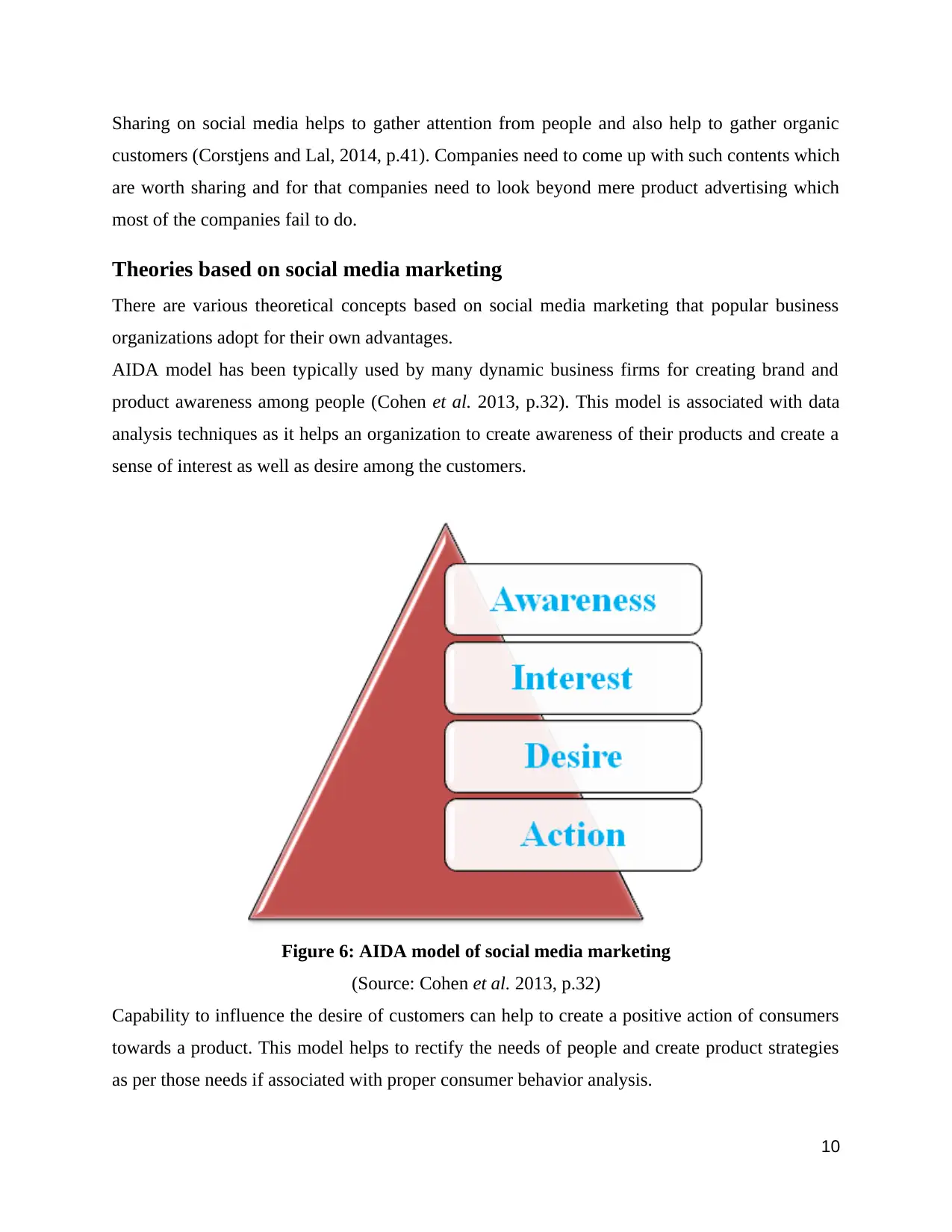
Sharing on social media helps to gather attention from people and also help to gather organic
customers (Corstjens and Lal, 2014, p.41). Companies need to come up with such contents which
are worth sharing and for that companies need to look beyond mere product advertising which
most of the companies fail to do.
Theories based on social media marketing
There are various theoretical concepts based on social media marketing that popular business
organizations adopt for their own advantages.
AIDA model has been typically used by many dynamic business firms for creating brand and
product awareness among people (Cohen et al. 2013, p.32). This model is associated with data
analysis techniques as it helps an organization to create awareness of their products and create a
sense of interest as well as desire among the customers.
Figure 6: AIDA model of social media marketing
(Source: Cohen et al. 2013, p.32)
Capability to influence the desire of customers can help to create a positive action of consumers
towards a product. This model helps to rectify the needs of people and create product strategies
as per those needs if associated with proper consumer behavior analysis.
10
customers (Corstjens and Lal, 2014, p.41). Companies need to come up with such contents which
are worth sharing and for that companies need to look beyond mere product advertising which
most of the companies fail to do.
Theories based on social media marketing
There are various theoretical concepts based on social media marketing that popular business
organizations adopt for their own advantages.
AIDA model has been typically used by many dynamic business firms for creating brand and
product awareness among people (Cohen et al. 2013, p.32). This model is associated with data
analysis techniques as it helps an organization to create awareness of their products and create a
sense of interest as well as desire among the customers.
Figure 6: AIDA model of social media marketing
(Source: Cohen et al. 2013, p.32)
Capability to influence the desire of customers can help to create a positive action of consumers
towards a product. This model helps to rectify the needs of people and create product strategies
as per those needs if associated with proper consumer behavior analysis.
10
Paraphrase This Document
Need a fresh take? Get an instant paraphrase of this document with our AI Paraphraser
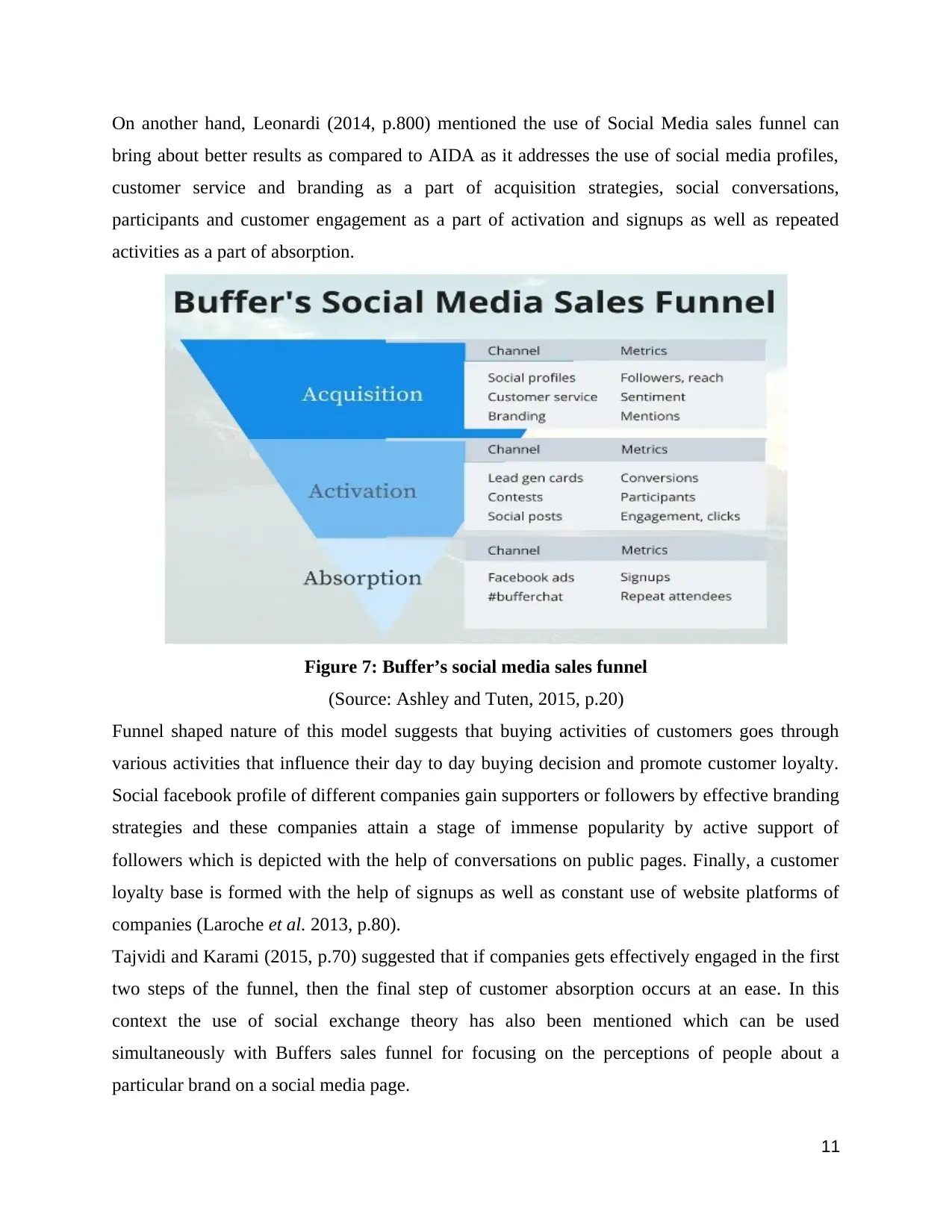
On another hand, Leonardi (2014, p.800) mentioned the use of Social Media sales funnel can
bring about better results as compared to AIDA as it addresses the use of social media profiles,
customer service and branding as a part of acquisition strategies, social conversations,
participants and customer engagement as a part of activation and signups as well as repeated
activities as a part of absorption.
Figure 7: Buffer’s social media sales funnel
(Source: Ashley and Tuten, 2015, p.20)
Funnel shaped nature of this model suggests that buying activities of customers goes through
various activities that influence their day to day buying decision and promote customer loyalty.
Social facebook profile of different companies gain supporters or followers by effective branding
strategies and these companies attain a stage of immense popularity by active support of
followers which is depicted with the help of conversations on public pages. Finally, a customer
loyalty base is formed with the help of signups as well as constant use of website platforms of
companies (Laroche et al. 2013, p.80).
Tajvidi and Karami (2015, p.70) suggested that if companies gets effectively engaged in the first
two steps of the funnel, then the final step of customer absorption occurs at an ease. In this
context the use of social exchange theory has also been mentioned which can be used
simultaneously with Buffers sales funnel for focusing on the perceptions of people about a
particular brand on a social media page.
11
bring about better results as compared to AIDA as it addresses the use of social media profiles,
customer service and branding as a part of acquisition strategies, social conversations,
participants and customer engagement as a part of activation and signups as well as repeated
activities as a part of absorption.
Figure 7: Buffer’s social media sales funnel
(Source: Ashley and Tuten, 2015, p.20)
Funnel shaped nature of this model suggests that buying activities of customers goes through
various activities that influence their day to day buying decision and promote customer loyalty.
Social facebook profile of different companies gain supporters or followers by effective branding
strategies and these companies attain a stage of immense popularity by active support of
followers which is depicted with the help of conversations on public pages. Finally, a customer
loyalty base is formed with the help of signups as well as constant use of website platforms of
companies (Laroche et al. 2013, p.80).
Tajvidi and Karami (2015, p.70) suggested that if companies gets effectively engaged in the first
two steps of the funnel, then the final step of customer absorption occurs at an ease. In this
context the use of social exchange theory has also been mentioned which can be used
simultaneously with Buffers sales funnel for focusing on the perceptions of people about a
particular brand on a social media page.
11
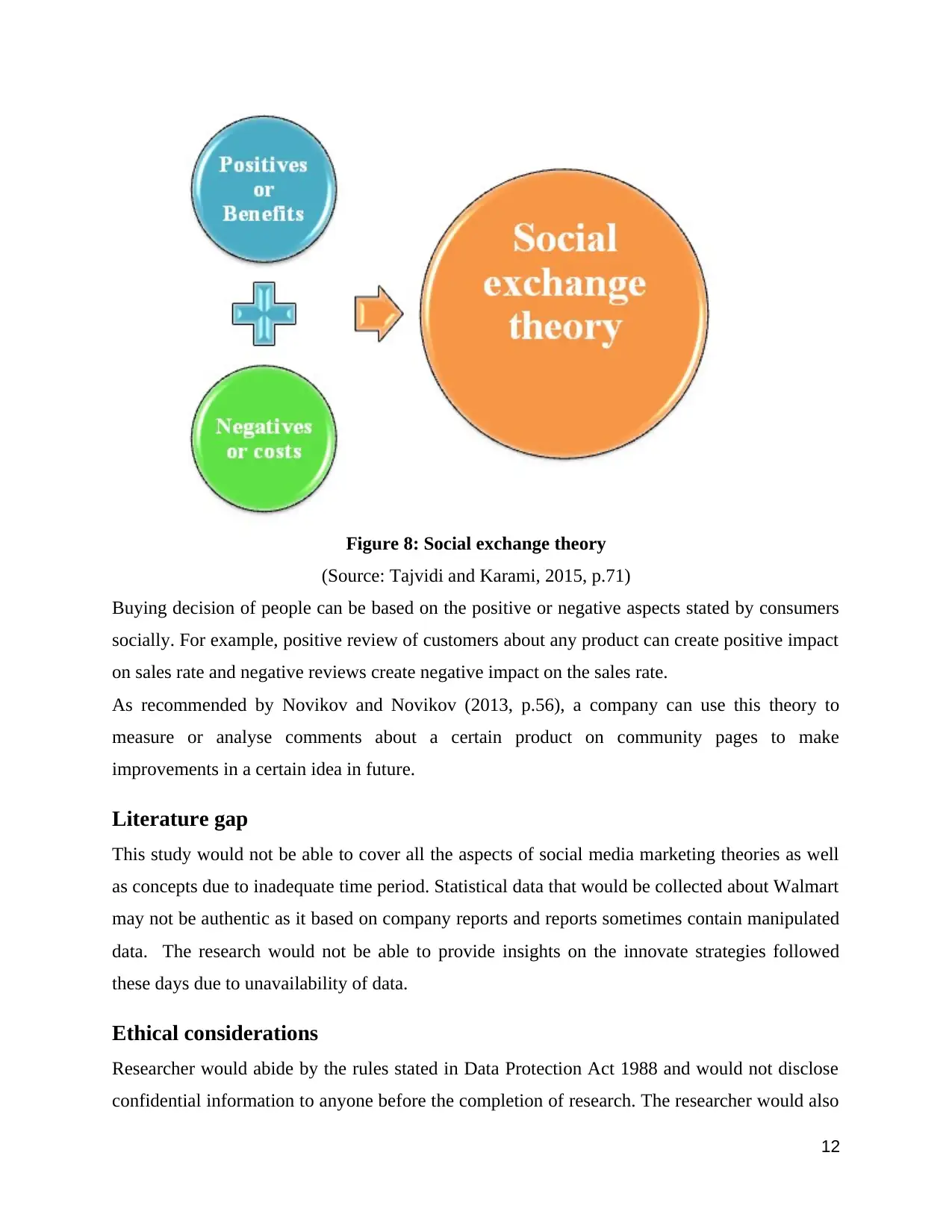
Figure 8: Social exchange theory
(Source: Tajvidi and Karami, 2015, p.71)
Buying decision of people can be based on the positive or negative aspects stated by consumers
socially. For example, positive review of customers about any product can create positive impact
on sales rate and negative reviews create negative impact on the sales rate.
As recommended by Novikov and Novikov (2013, p.56), a company can use this theory to
measure or analyse comments about a certain product on community pages to make
improvements in a certain idea in future.
Literature gap
This study would not be able to cover all the aspects of social media marketing theories as well
as concepts due to inadequate time period. Statistical data that would be collected about Walmart
may not be authentic as it based on company reports and reports sometimes contain manipulated
data. The research would not be able to provide insights on the innovate strategies followed
these days due to unavailability of data.
Ethical considerations
Researcher would abide by the rules stated in Data Protection Act 1988 and would not disclose
confidential information to anyone before the completion of research. The researcher would also
12
(Source: Tajvidi and Karami, 2015, p.71)
Buying decision of people can be based on the positive or negative aspects stated by consumers
socially. For example, positive review of customers about any product can create positive impact
on sales rate and negative reviews create negative impact on the sales rate.
As recommended by Novikov and Novikov (2013, p.56), a company can use this theory to
measure or analyse comments about a certain product on community pages to make
improvements in a certain idea in future.
Literature gap
This study would not be able to cover all the aspects of social media marketing theories as well
as concepts due to inadequate time period. Statistical data that would be collected about Walmart
may not be authentic as it based on company reports and reports sometimes contain manipulated
data. The research would not be able to provide insights on the innovate strategies followed
these days due to unavailability of data.
Ethical considerations
Researcher would abide by the rules stated in Data Protection Act 1988 and would not disclose
confidential information to anyone before the completion of research. The researcher would also
12
⊘ This is a preview!⊘
Do you want full access?
Subscribe today to unlock all pages.

Trusted by 1+ million students worldwide
1 out of 15
Related Documents
Your All-in-One AI-Powered Toolkit for Academic Success.
+13062052269
info@desklib.com
Available 24*7 on WhatsApp / Email
![[object Object]](/_next/static/media/star-bottom.7253800d.svg)
Unlock your academic potential
Copyright © 2020–2025 A2Z Services. All Rights Reserved. Developed and managed by ZUCOL.





